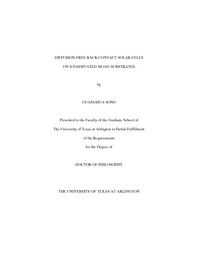
ATTENTION: The works hosted here are being migrated to a new repository that will consolidate resources, improve discoverability, and better show UTA's research impact on the global community. We will update authors as the migration progresses. Please see MavMatrix for more information.
Show simple item record
| dc.contributor.author | Song, Guanghua | en_US |
| dc.date.accessioned | 2008-04-22T02:41:16Z | |
| dc.date.available | 2008-04-22T02:41:16Z | |
| dc.date.issued | 2008-04-22T02:41:16Z | |
| dc.date.submitted | December 2007 | en_US |
| dc.identifier.other | DISS-1968 | en_US |
| dc.identifier.uri | http://hdl.handle.net/10106/766 | |
| dc.description.abstract | A diffusion-free back contact solar cell is proposed in this work. The textured front-side of this cell is coated with ~100 nm thermal SiO2 to enhance the light trapping meanwhile reduce the surface recombination velocity (SRV). The back-side of this cell is finger-patterned, using a diffusion-free junction as its emitter region and Al-Si alloy as its base contact. The diffusion-free junction is made by a Schottky contact between low work-function metal aluminum (Al) and sulfur (S)-passivated p-type Si(100) surface.
Solution-based S passivation is one of the experimental realizations of the "valence-mending concept". Previously developed MBE (molecular bean epitaxy) selenium (Se) passivation is not used due to its time-consuming process and high energy input. Following the concept, passivation of Si(100) surface by Group VI elements such as S and Se terminates the dangling bonds and releases the strained bonds and dimer bonds, thus significantly reduces the surface states.
Quantification of surface states or interface states is introduced through the nano-CMOS devices. Removal of surface states enables an almost ideal barrier height after metal contact. This is one of the methods achieving the high Schottky barrier.
Al on S-passivated p-type Si(100) surface yields an extremely high Schottky barrier of 1.1 eV, about 0.2 eV higher than the corresponding ideal barrier height. This discrepancy is accounted by S-Si dipole moment on the surface. Calculations using Fermi statistics discloses that the barrier height of 1.1 eV causes the degenerate inversion on Si surface, making this Schottky junction electrically behave like a diffused p-n junction. Eventually this junction as a field-induced junction free of any diffusion is integrated in the fabrication of the proposed back contact solar cells. High work-function metal Platinum (Pt) and nickel (Ni) on S-passivated n-type Si(100) are also investigated, but the yielding barrier heights are not high enough to create degenerate inversion on Si surface.
Due to many limiting factors such as surface passivation quality, SRV, bulk minority-carrier lifetime, etc., for the fabricated solar cells, the measured low conversion efficiency of ~1% should be a reasonable value. The future work is proposed to further improve the cells performance. | en_US |
| dc.description.sponsorship | Tao, Meng | en_US |
| dc.language.iso | EN | en_US |
| dc.publisher | Materials Science & Engineering | en_US |
| dc.title | Diffusion-free Back Contact Solar Cells On S-passivated Si(100) Substrates | en_US |
| dc.type | Ph.D. | en_US |
| dc.contributor.committeeChair | Tao, Meng | en_US |
| dc.degree.department | Materials Science & Engineering | en_US |
| dc.degree.discipline | Materials Science & Engineering | en_US |
| dc.degree.grantor | University of Texas at Arlington | en_US |
| dc.degree.level | doctoral | en_US |
| dc.degree.name | Ph.D. | en_US |
| dc.identifier.externalLink | https://www.uta.edu/ra/real/editprofile.php?onlyview=1&pid=291 | |
| dc.identifier.externalLinkDescription | Link to Research Profiles | |
Files in this item
- Name:
- umi-uta-1968.pdf
- Size:
- 7.120Mb
- Format:
- PDF
This item appears in the following Collection(s)
Show simple item record


